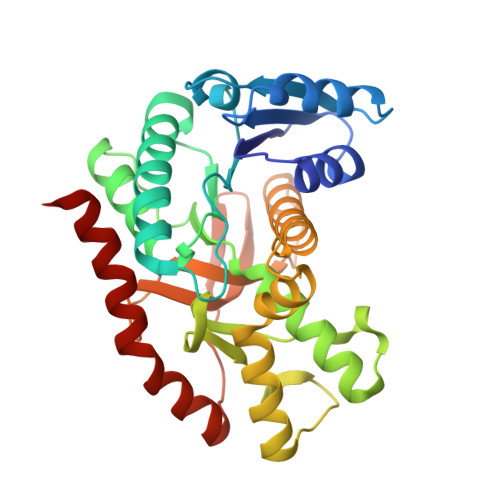Insertions and deletions mediated functional divergence of Rossmann fold enzymes.
Toledo-Patino, S., Pascarelli, S., Uechi, G.I., Laurino, P.(2022) Proc Natl Acad Sci U S A 119: e2207965119-e2207965119
- PubMed: 36417431
- DOI: https://doi.org/10.1073/pnas.2207965119
- Primary Citation of Related Structures:
7XQM, 7XQN - PubMed Abstract:
Nucleobase-containing coenzymes are hypothesized to be relics of an early RNA-based world that preceded the emergence of proteins. Despite the importance of coenzyme-protein synergisms, their emergence and evolution remain understudied. An excellent target to address this issue is the Rossmann fold, the most catalytically diverse and abundant protein architecture in nature. We investigated two main Rossmann lineages: the nicotinamide adenine dinucleotide phosphate (NAD(P)) and the S-adenosyl methionine (SAM)- binding superfamilies. To identify the evolutionary changes that lead to a coenzyme specificity switch on these superfamilies, we performed structural and sequence-based Hidden Markov model analysis to systematically search for key motifs in their coenzyme-binding pockets. Our analyses revealed that through insertions and deletions (InDels) and a residue substitution, the ancient β1-loop-α1 coenzyme-binding structure of NAD(P) could be reshaped into the SAM-binding β1-loop-α1 structure. To experimentally prove this obsevation, we removed three amino acids from the NAD(P)-binding pocket and solved the structure of the resulting mutant, revealing the characteristic loop features of the SAM-binding pocket. To confirm the binding to SAM, we performed isothermal titration calorimetry measurements. Molecular dynamics simulations also corroborated the role of InDels in abolishing NAD binding and acquiring SAM binding. Our results uncovered how nature may have utilized insertions and deletions to optimize the different coenzyme-binding pockets and the distinct functionalities observed for Rossmann superfamilies. This work also proposes a general mechanism by which protein templates could have been recycled through the course of evolution to adopt different coenzymes and confer distinct chemistries.
- Protein Engineering and Evolution Unit, Okinawa Institute of Science and Technology Graduate University, Onna Son, Okinawa 904-0495, Japan.
Organizational Affiliation:
















